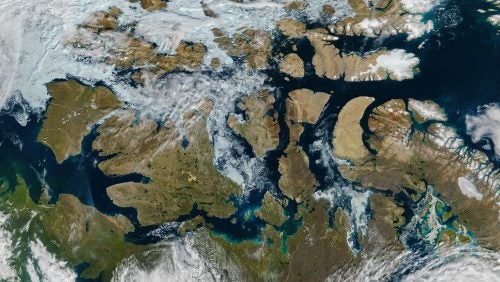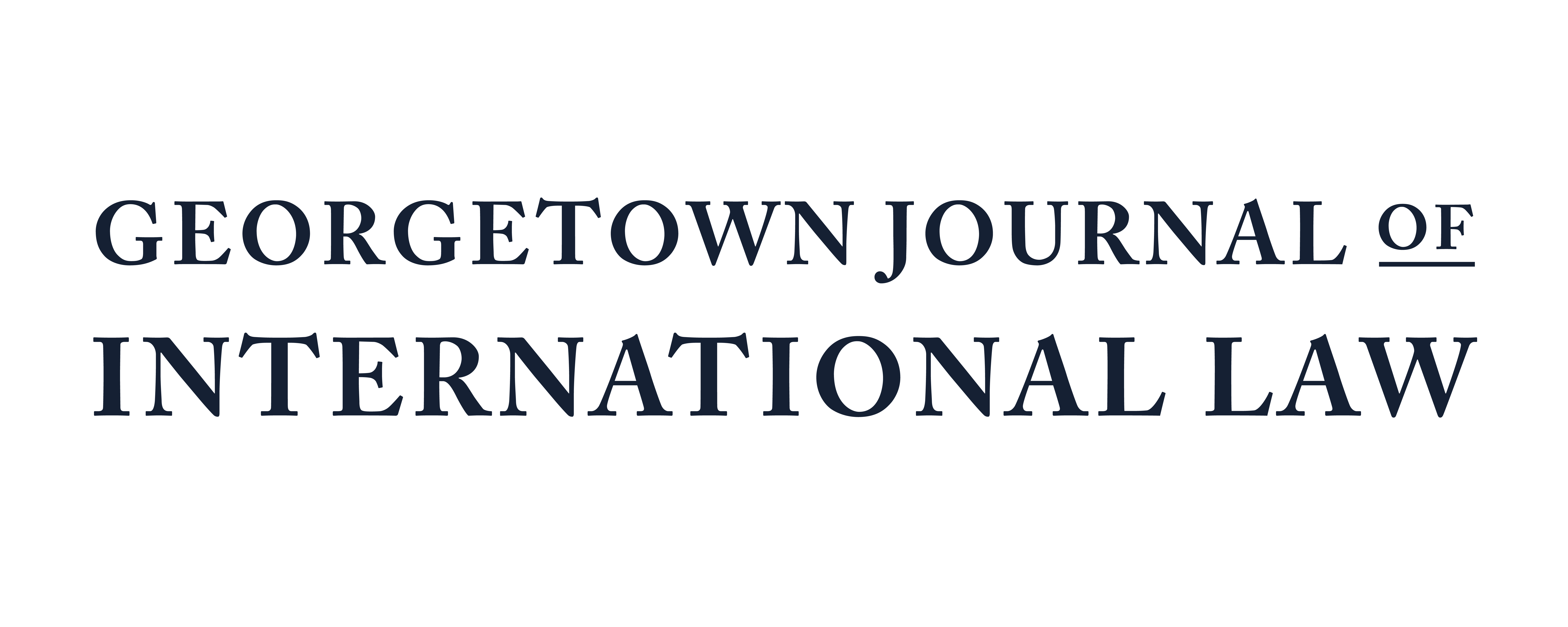Agree to Disagree: Revisiting the Legal Status of Canada’s Northwest Passage Claim
April 26, 2021 by Digital Editor

NASA satellite image by Jeff Schmaltz showing a nearly ice-free Northwest Passage
By Astrid Arzu
One of the most recognized alliances in the international sphere is the relationship between Canada and the United States. Famous for having the longest shared international border at 5,525 miles, as well as the northern border with Alaska, the Yukon and British Columbia, it has long been clear to both nations that cooperation is an imperative. Indeed, there have been no notable armed conflicts between the two countries since the War of 1812, when Canada was still a British colony. Even when there are disputes, cooperation tends to be the method of resolution.
This cooperative principle is extremely evident in the Agreement Between the Government of Canada and the Government of the United States of America on Arctic Cooperation, signed in 1988 and better known simply as the Arctic Cooperation Agreement, which was intended to resolve the dispute between Canada and the United States over the legal status of the Northwest Passage. The Northwest Passage refers to a series of waterways in the Canadian Arctic Archipelago. As made evident in the third paragraph of the treaty, Canada claims these waters as “internal” waters. However, the United States’ position is that the waters ought to be classified as an international strait. By the treaty’s terms, the US does not concede that the waters of the Northwest Passage are “internal,” but agrees to obtain Canada’s permission to navigate icebreakers through the waters that Canada claims are internal.
Essentially, the treaty is an agreement to disagree, allowing both countries to use the passage without having to finalize the question of how the passage should be characterized. To this point, the fourth paragraph states that nothing in the agreement “affects the respective positions of the Governments of the United States and of Canada on the Law of the Sea.” However, as the Arctic waters have warmed, the Northwest Passage has experienced decreased sea ice during the summer months, allowing for easier transit through the Northwest Passage. The passage is no longer ice-covered, and icebreakers are not an absolute necessity to traverse the waterway. With this new development in the Arctic saga, perhaps now is the time to revisit the Arctic Cooperation Agreement.
In order to appreciate why melting sea ice is significant, it is necessary to review the legal positions of Canada and the United States with regard to the Northwest Passage. Canada claims the waters of the Northwest Passage as internal waters, and there is historic evidence to verify this claim. As legal scholar Donald McRae writes, prior to becoming a party to the United Nations Convention on the Law of the Sea (UNCLOS) and in accordance with customary international law, Canada drew straight baselines around its Arctic Archipelago. In doing so, it “consolidat[ed] the claim that these are Canadian internal waters by virtue of historic title.” Under article 2(1) of UNCLOS, the coastal state has full sovereignty over its internal waters and, as a result, there is no inherent right of innocent passage to any foreign military vessels, like the icebreakers utilized by the United States Coast Guard.
As mentioned above, the United States holds the contrary position that the Northwest Passage is an international strait, where the right of transit passage would allow all ships, including military ships, to freely transit without having their passage suspended. The first requirement for an international strait to be established where a right of transit passage exists, as set out in Article 37 of UNCLOS and the International Court of Justice’s (ICJ) 1948 Corfu Channel Case, is that the strait must connect “…one part of the high seas or an exclusive economic zone and another part of the high seas or an exclusive economic zone.” The Northwest Passage is a link between the Atlantic Ocean and Pacific Ocean, and therefore obviously meets this first requirement.
However, there is a second requirement that may not be so easily met. As stated on page 28 of the Corfu Channel Case, the strait must also be used for “international navigation.” The issue is that the Northwest Passage has historically been treated by international bodies as an internal passage, and travelers have dutifully requested Canada’s permission to pass through it. As discussed in a recent article on the issue, written by Cornell Overfield, “…all voyages in the Northwest Passage since 1969 are linked by an unbroken chain of Canadian consent and control.” This strongly suggests a practice of treating the Northwest Passage as Canada’s internal waters, rather than the exercise of a right of transit passage.
However, with the Arctic ice melting, the waters are becoming more easily traversed by civilian-manned crafts, rather than the military operated icebreakers that have habitually requested Canadian governmental approval before pushing through the passage. In August of 2020, the New Zealand pleasure craft, Kiwi Roa, transited the Northwest Passage without explicit permission to do so. It was reported that Canadian officials advised the owner who was piloting the Kiwi Roa at the time, that the yacht would have to leave Canadian waters; however, due to COVID-19 restrictions, the owner held the position that “…Canada has no legal right to apply Canadian law to a foreigner in [an] international waterway.” In his article, Overfield wrote that the Kiwi Roa’s successful navigation of the Northwest Passage was the first time a vessel had relied on a right of innocent passage in defiance of Canadian authority.
It is as yet unclear what the consequences of the Kiwi Roa’s transit might be. In the short term, it does not seem too significant; arguably one transit of the Northwest Passage in defiance of Canada’s consent and control is not enough to establish it as a strait used for international navigation. Nevertheless, this could open the door to other such transits of the Northwest Passage by those who do not recognize it as Canada’s internal waters, especially now that global warming has opened the passage to more types of vessels than ever before. It could be that this simple act of defiance sets a new precedent, encouraging similar acts that push the international navigation analysis away from Canada’s historical hold on the passage and closer to the United States’ position that the passage be classified as an international strait.
It might be the right time to settle the legal status of the Northwest Passage by creating a concrete resolution between the United States and Canada. In paragraph three of the Arctic Cooperation Agreement, the United States has pledged that all navigation by U.S. icebreakers in waters that Canada claims are “internal” will be done with Canada’s consent. As the United States has already agreed to treat those waters as if they were Canadian internal waters, it would make sense to continue the practice as a legal rule by recognizing Canada’s claim and working towards an agreement for navigation that is beneficial to both countries. Such an agreement is also in the United States’ best interests, as increased activity in the fragile Arctic will be difficult to manage “…absent [an] agreement between the U.S. and Canada.” It would also be in the United States’ best interests to limit the number of unaffiliated vessels that may freely traverse the waterways that run so near the US border. The hope would be that a resolution on the legal status of the Northwest Passage by these two countries – each of which have great stakes in the matter – would help strengthen the understanding of the Northwest Passage’s status in the international sphere and encourage the rest of the world to follow suit, resolving this matter once and for all.
Astrid Arzu is an LL.M. Digital Advisor for the Georgetown Journal of International Law. She holds a J.D. from the University of Alberta Faculty of Law in Canada. Her interests include national security law, US/Canada relations, and Arctic security issues. Before attending Georgetown Law, she worked as legal counsel in Toronto at the Ontario Ministry of the Attorney General, conducting oversight investigations and resolving disputes regarding policing services. Her prior experience includes working in policy development with the Government of Alberta and interning with the Office of the Judge Advocate General of the Canadian Armed Forces.

